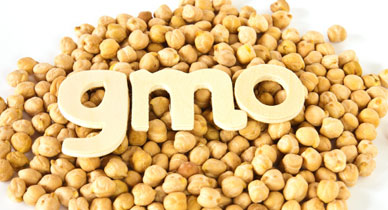Experts clash over accusations made in HBO show on GMO crops concerning seed costs, pesticides, and resistant weeds.
 Are genetically engineered crops the only way to solve the planet’s growing demand for food or are they leading us toward a world of pesticide-filled fields tilled only by rich farmers?
Are genetically engineered crops the only way to solve the planet’s growing demand for food or are they leading us toward a world of pesticide-filled fields tilled only by rich farmers?
That’s the debate that has spun out of an HBO program that detailed some of the controversy surrounding using genetically modified organisms (GMOs) for food.
The segment, entitled “Savior Seeds,” aired last Friday evening as part of theHBO series Vice.
Much of the focus was on farmers in Paraguay who purchased seeds from the agribusiness giant Monsanto to grow genetically engineered crops.
Not surprisingly, those who believe science can improve farming were critical of the report. Officials from Monsanto were particularly displeased.
“We understand that these are big, challenging topics and know it’s a lot to boil down into one story,” a press release from Monsanto stated. “However, in the case of Vice, we feel that they didn’t include the whole picture about the future of food, the challenges our planet faces, and how we are helping farmers around the world.”
But those who believe generically engineered crops present environmental and financial problems applauded the segment.
“They covered all the bases. They did a good job of covering all the concerns,” said Alexis Baden-Mayer, political director of the Organic Consumers Association.
Get the Facts: The Pros and Cons of GMOs »
Sowing the Seeds of Controversy
While controversy surrounding GMO food has continued to simmer, the crops have taken root in a growing number of fields in the United States and around the world.
According to the Center for Science in the Public Interest (CSPI), there are 18 million farmers in 28 countries who planted genetically engineered crops on 447 million acres in 2014.
In the United States, 93 percent of corn, 94 percent of soybeans, 95 percent of sugar beets, and 96 percent of cotton is genetically engineered.
There are no major studies that show these crops are unhealthy for humans to eat. However, there are other issues that have cropped up.
There were four major points in the Vice report that Healthline asked experts on both sides of the issue to weigh in on.
The first was the fact that Monsanto requires farmers to sign a contract that forces them to buy new genetically engineered seeds every year instead of using seeds from their harvest.
Nina Fedoroff, a professor of life sciences at Pennsylvania State University, said the practice of using new seeds every year has been going on for decades. Fedoroff is also a former board member of the American Association for the Advancement of Science, which supports GMO agriculture.
Farmers, she said, have been replenishing their seed ever since hybrid crops gained traction during the 1930s economic depression in the United States.
Fedoroff said the hybrid seeds have been popular because they produce more crops per acre. She said that higher yield is also true for genetically engineered seeds. In addition, seeds that are used from harvested crops simply aren’t as effective.
Greg Jaffe, the CSPI’s biotech director, agrees. Neither he nor Fedoroff had seen the full Vice program.
Monsanto is trying to protect their intellectual property rights with their seeds just as Microsoft does with its Windows software programs, Jaffe said.
“I don’t think this is anything different for Monsanto,” he said.
But Baden-Mayer said the Monsanto seeds are being used for crops, including soybeans, which farmers historically have grown from harvested seeds.
“Monsanto has made their seeds a huge lucrative market worldwide,” she said.
Organic Consumers Association asserts that agricultural companies should not be able to hold patents on things such as seeds and crops.
“You shouldn’t be able to patent life,” Baden-Mayer said.
Pesticides Present a Problem
The Vice program also questioned the ethics and environmental implications of Monsanto’s GMO crops that are resistant to its own weed killer, Roundup.
To continue using Monsanto seeds, the report alleged, farmers must keep buying Monsanto chemicals.
Baden-Mayer said this practice is simply a way for Monsanto to pad its profits. Monsanto reported a profit of $2.7 billion in 2014, up 10 percent from 2013. Monsanto attributes its growth to Roundup sales and royalties on its GMO soybean seeds.
“They have clearly kept that market alive,” Baden-Mayer said. “They have these products that are gold mines for them.”
Fedoroff, however, said herbicides like Roundup were an obvious choice because they are among the least toxic pesticides and they don’t stay in the ground all that long.
“It was a very logical place to start,” said Fedoroff.
But weeds that sprout in the fields next to Monsanto’s Roundup-resistant GMO crops have also become resistant to the pesticide.
Only a few types of chemicals can be used on GMO crops. Farmers use only the pesticides that the crops are designed to resist instead of rotating herbicides and insecticides as recommended. That allows weeds to become quickly resistant to those chemicals.
There are now 14 types of weeds in the United States that are resistant to Roundup, according to Jaffe. They are thriving on 60 million acres in 22 states.
Resistant weeds have always dogged farmers, Jaffe said, but the problem has been escalating since farmers planted the first genetically engineered soybeans in 1996.
“Nature will always figure out a way around things,” he said. But farmers can adopt other strategies to limit weeds with GMO crops.
“This technology does not have to lead to resistant weeds,” Jaffe said.
Fedoroff said companies like Monsanto are now developing pesticides that can eradicate the resistant weeds. She said once those are brought to market, farmers will be able to rotate the chemicals used on their fields. That should greatly reduce the problem, she said.
But while believers in science maintain that newer, better science will fix the problems introduced by current technology, critics like Baden-Mayer say GMO crops are creating a cycle where a chemical is used for awhile, then when weeds become resistant another is developed. When that second chemical no longer works, a third toxic chemical is introduced.
A critic in the Vice report described the situation as “chemical warfare.” Baden-Mayer calls it a “chemical treadmill.”
“Sadly, we are seeing a large increase in the use of these pesticides,” she said.
Related News: Golden Rice and Super Bananas Part of an Experiment to Deliver Vitamin A to the Poor »
For Richer or Poorer?
Advocates and critics of GMO farming also spar over whether the technology helps or hurts subsistence farmers.
Critics interviewed in the Vice program said farmers on the lower end of the economic scale couldn’t afford the annual purchase of seeds or the new wave of agricultural chemicals.
It noted that 80 percent of the farmland in Paraguay is owned by 2 percent of the farmers.
Farming has traditionally not been an industry that generates huge profits. It’s a tight-margin business, much like restaurants.
But that’s changing now with the rise in genetically engineered crops that favor richer farmers and generate large sums of revenue for companies like Monsanto, according to Baden-Mayer.
GMO crops have “changed the economies of farming,” she said.
But seeds and pesticides aren’t the only financial problems for poor farmers, CSPI’s Jaffe said. They also have trouble paying for water and other things.
“There are a lot of constraints on poor farmers,” he said.
Fedoroff said low-income farmers can actually cut expenses with genetic crops because of the higher yields and the reduced use of pesticides. That also saves in labor costs, she said.
“The poorest farmers benefit the most,” Fedoroff said.
The only way to feed the world’s growing population is to produce higher yields, Fedoroff believes. There are 7.2 billion people on Earth now, but we are farming the same number of acres that we did 50 years ago.
The only way to get more out of that land, Fedoroff said, is with advancements such as genetically engineered crops.
“This can only be solved with more science, not less science,” she said. But Jaffe pointed to a possible middle ground: the regulation of GMO crops.
The U.S. Food and Drug Administration should approve new genetic crops and there should be more oversight, he said. The problem of resistant weeds needs to be addressed, too.
“We need to make sure the benefits that do exist will exist not only for today’s farmers but also for tomorrow’s farmers,” he said.

